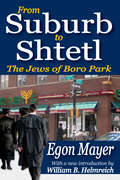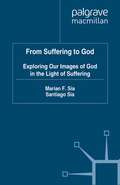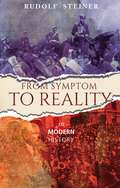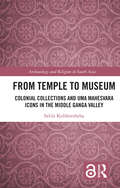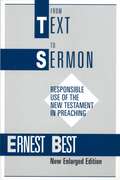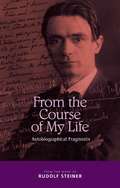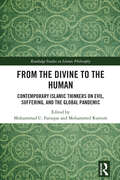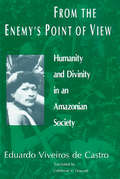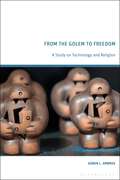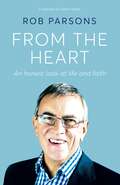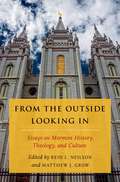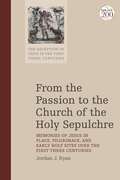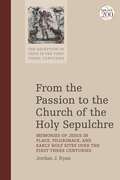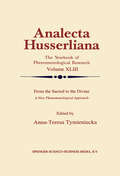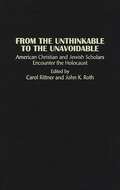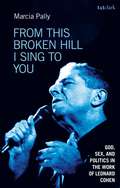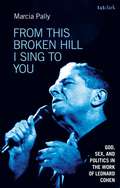- Table View
- List View
From Suburb to Shtetl: The Jews of Boro Park
by Egon Mayer William B. Helmreich"From Suburb to Shtetl" is an outstanding ethnography that moves beyond simple demographics. Mayer weaves an intricate tapestry of how family, school, and community leaders influence each other. Whether discussing the role of the rebbe or the matchmaker, those who know these communities will find what he says as relevant today as it was when first penned. This is hardly surprising, for the ultra-Orthodox community takes great pride in not changing, in maintaining itself as it was in Europe despite the allure of modern American society. His discussion of synagogue life is particularly informative and evocative. Those in charge of helping immigrants adopted the path of least resistance, allowing and even encouraging them to retain their identities except for those few aspects that might threaten the country's national interests. The American Orthodox community was tremendously augmented by the arrival from Europe, after World War Two, of thousands of Orthodox Jews who remained devoted to that way of life. Egon Mayer was himself part of a smaller, but significant group of Jews who came to the U.S. and settled mostly in Boro Park in the wake of the 1956 Hungarian Revolution. The interaction between the Hasidim and their less fervent Orthodox counterparts described and analyzed in this volume tells us a great deal about how people negotiate their beliefs, values, and norms when forced into close contact with each other in an urban setting within the larger American culture. By exploring these and many other related issues Mayer has given us the chance to assess and forecast the future of American Jewish life as a whole.
From Suffering to God: Exploring our Images of God in the Light of Suffering
by Santiago Sia'A splendid book! The authors give a moving account of a tragic aspect of our present human world. It is a scholarly, learned account.' - Charles Hartshorne, Professor Emeritus of Philosophy, University of Texas at Austin Does the reality of suffering disclose anything about God's nature? The authors address this fundamental question by reflecting on some theistic responses to the challenge of suffering. Taking seriously the persistence of theistic belief despite widespread suffering, they focus on the practical ways some believers deal with suffering: by 'suffering with those in affliction' and 'working for the liberation of those who are opposed.' They then investigate the possibility of describing God as 'co-sufferer' and 'liberator.' In their exploration they turn to literature, theology and philosophy and offer an interesting interpretation of the relationship between these disciplines. Part I contains literary and descriptive reflections on the experiences of certain theists faced with the reality of suffering. The authors present and analyse the concerns, fears and hopes expressed in the book of Job and selected poems by Hopkins, Vaughan, Donne and Herbert. They then try to show that an important challenge that needs to be investigated and met, given the presence of so much suffering in the world, is discovering the kind of God in whom we can credibly continue to believe. This question is developed theologically and philosophically in Part II. In developing some answers, the authors turn to Latin American liberation theology and Charles Hartshorne's process philosophy and offer a new synthesis of these two schools of thought. Their exploration is an interesting illustration of how literature, theology and philosophy can throw some light on an area of common concern.
From Symptom to Reality: In Modern History
by Rudolf SteinerIn a radical approach to understanding current affairs and history, Rudolf Steiner presents a method of penetrating to the hidden causes and realities that lie behind outer appearances. Contemporary life cannot fully be understood by an analysis that is restricted to external events, he says. Deeper levels of meaning are revealed when one begins to view such events as symptoms. The causes of these symptoms – the reality behind them – are to be discovered on other levels of existence.
From Temple to Museum: Colonial Collections and Umā Maheśvara Icons in the Middle Ganga Valley (Archaeology and Religion in South Asia)
by Salila KulshreshthaReligious icons have been a contested terrain across the world. Their implications and understanding travel further than the artistic or the aesthetic and inform contemporary preoccupations.This book traces the lives of religious sculptures beyond the moment of their creation. It lays bare their purpose and evolution by contextualising them in their original architectural or ritual setting while also following their displacement. The work examines how these images may have moved during different spates of temple renovation and acquired new identities by being relocated either within sacred precincts or in private collections and museums, art markets or even desecrated and lost. The book highlights contentious issues in Indian archaeology such as renegotiating identities of religious images, reuse and sharing of sacred space by adherents of different faiths, rebuilding of temples and consequent reinvention of these sites. The author also engages with postcolonial debates surrounding history writing and knowledge creation in British India and how colonial archaeology, archival practices, official surveys and institutionalisation of museums has influenced the current understanding of religion, sacred space and religious icons. In doing so it bridges the historiographical divide between the ancient and the modern as well as socio-religious practices and their institutional memory and preservation. Drawn from a wide-ranging and interdisciplinary study of religious sculptures, classical texts, colonial archival records, British travelogues, official correspondences and fieldwork, the book will interest scholars and researchers of history, archaeology, religion, art history, museums studies, South Asian studies and Buddhist studies.
From Temple to Museum: Colonial Collections and Umā Maheśvara Icons in the Middle Ganga Valley (Archaeology and Religion in South Asia)
by Salila KulshreshthaReligious icons have been a contested terrain across the world. Their implications and understanding travel further than the artistic or the aesthetic and inform contemporary preoccupations.This book traces the lives of religious sculptures beyond the moment of their creation. It lays bare their purpose and evolution by contextualising them in their original architectural or ritual setting while also following their displacement. The work examines how these images may have moved during different spates of temple renovation and acquired new identities by being relocated either within sacred precincts or in private collections and museums, art markets or even desecrated and lost. The book highlights contentious issues in Indian archaeology such as renegotiating identities of religious images, reuse and sharing of sacred space by adherents of different faiths, rebuilding of temples and consequent reinvention of these sites. The author also engages with postcolonial debates surrounding history writing and knowledge creation in British India and how colonial archaeology, archival practices, official surveys and institutionalisation of museums has influenced the current understanding of religion, sacred space and religious icons. In doing so it bridges the historiographical divide between the ancient and the modern as well as socio-religious practices and their institutional memory and preservation. Drawn from a wide-ranging and interdisciplinary study of religious sculptures, classical texts, colonial archival records, British travelogues, official correspondences and fieldwork, the book will interest scholars and researchers of history, archaeology, religion, art history, museums studies, South Asian studies and Buddhist studies.
From Text to Sermon
by Ernest BestBest identifies the most common problems facing anyone who seeks to interpret the New Testament. He then shows how the preacher, teacher or ordinary reader can faithfully draw out the meaning of the New Testament.
From the Course of My Life: Autobiographical Fragments
by Rudolf SteinerRudolf Steiner found the spiritual science of anthroposophy and the many practical disciplines that arose from it. Eventually, he would write his Autobiography, although its composition would be interrupted by his unexpected death. This volume is an essential complement to Steiner's unfinished autobiography. It gathers a wealth of personal testimonies, lectures, résumés, notebook entries, a questionnaire, and biographical notes written for Édouard Schuré - much of which has not been previously published in English.
From the Divine to the Human: Contemporary Islamic Thinkers on Evil, Suffering, and the Global Pandemic (Routledge Studies in Islamic Philosophy)
by Muhammad U. Faruque Mohammed RustomFeaturing the work of leading contemporary Muslim philosophers and theologians, this book grapples with various forms of evil and suffering in the world today, from COVID-19 and issues in climate change to problems in palliative care and human vulnerability. Rather than walking down well-trodden paths in philosophy of religion which often address questions of evil and suffering by focusing on divine attributes and the God-world relationship, this volume offers another path of inquiry by focusing on human vulnerability, potential, and resilience. Addressing both the theoretical and practical dimensions of the question of evil, topics range from the transformative power of love, virtue ethics in Sufism and the necessity of suffering, to the spiritual significance of the body and Islamic perspectives on embodiment. In doing so, the contributors propose new perspectives based on various pre-modern and contemporary materials that can enrich the emerging field of the global philosophy of religion, thereby radically transforming contemporary debates on the nature of evil and suffering. The book will appeal to researchers in a variety of disciplines, including Islamic philosophy, religious studies, Sufism, and theology.
From the Divine to the Human: Contemporary Islamic Thinkers on Evil, Suffering, and the Global Pandemic (Routledge Studies in Islamic Philosophy)
by Muhammad U. Faruque Mohammed RustomFeaturing the work of leading contemporary Muslim philosophers and theologians, this book grapples with various forms of evil and suffering in the world today, from COVID-19 and issues in climate change to problems in palliative care and human vulnerability. Rather than walking down well-trodden paths in philosophy of religion which often address questions of evil and suffering by focusing on divine attributes and the God-world relationship, this volume offers another path of inquiry by focusing on human vulnerability, potential, and resilience. Addressing both the theoretical and practical dimensions of the question of evil, topics range from the transformative power of love, virtue ethics in Sufism and the necessity of suffering, to the spiritual significance of the body and Islamic perspectives on embodiment. In doing so, the contributors propose new perspectives based on various pre-modern and contemporary materials that can enrich the emerging field of the global philosophy of religion, thereby radically transforming contemporary debates on the nature of evil and suffering. The book will appeal to researchers in a variety of disciplines, including Islamic philosophy, religious studies, Sufism, and theology.
From the Enemy's Point of View: Humanity and Divinity in an Amazonian Society
by Eduardo Viveiros de CastroThe Araweté are one of the few Amazonian peoples who have maintained their cultural integrity in the face of the destructive forces of European imperialism. In this landmark study, anthropologist Eduardo Viveiros de Castro explains this phenomenon in terms of Araweté social cosmology and ritual order. His analysis of the social and religious life of the Araweté—a Tupi-Guarani people of Eastern Amazonia—focuses on their concepts of personhood, death, and divinity. Building upon ethnographic description and interpretation, Viveiros de Castro addresses the central aspect of the Arawete's concept of divinity—consumption—showing how its cannibalistic expression differs radically from traditional representations of other Amazonian societies. He situates the Araweté in contemporary anthropology as a people whose vision of the world is complex, tragic, and dynamic, and whose society commands our attention for its extraordinary openness to exteriority and transformation. For the Araweté the person is always in transition, an outlook expressed in the mythology of their gods, whose cannibalistic ways they imitate. From the Enemy's Point of View argues that current concepts of society as a discrete, bounded entity which maintains a difference between "interior" and "exterior" are wholly inappropriate in this and in many other Amazonian societies.
From the Enemy's Point of View: Humanity and Divinity in an Amazonian Society
by Eduardo Viveiros de CastroThe Araweté are one of the few Amazonian peoples who have maintained their cultural integrity in the face of the destructive forces of European imperialism. In this landmark study, anthropologist Eduardo Viveiros de Castro explains this phenomenon in terms of Araweté social cosmology and ritual order. His analysis of the social and religious life of the Araweté—a Tupi-Guarani people of Eastern Amazonia—focuses on their concepts of personhood, death, and divinity. Building upon ethnographic description and interpretation, Viveiros de Castro addresses the central aspect of the Arawete's concept of divinity—consumption—showing how its cannibalistic expression differs radically from traditional representations of other Amazonian societies. He situates the Araweté in contemporary anthropology as a people whose vision of the world is complex, tragic, and dynamic, and whose society commands our attention for its extraordinary openness to exteriority and transformation. For the Araweté the person is always in transition, an outlook expressed in the mythology of their gods, whose cannibalistic ways they imitate. From the Enemy's Point of View argues that current concepts of society as a discrete, bounded entity which maintains a difference between "interior" and "exterior" are wholly inappropriate in this and in many other Amazonian societies.
From the Enemy's Point of View: Humanity and Divinity in an Amazonian Society
by Eduardo Viveiros de CastroThe Araweté are one of the few Amazonian peoples who have maintained their cultural integrity in the face of the destructive forces of European imperialism. In this landmark study, anthropologist Eduardo Viveiros de Castro explains this phenomenon in terms of Araweté social cosmology and ritual order. His analysis of the social and religious life of the Araweté—a Tupi-Guarani people of Eastern Amazonia—focuses on their concepts of personhood, death, and divinity. Building upon ethnographic description and interpretation, Viveiros de Castro addresses the central aspect of the Arawete's concept of divinity—consumption—showing how its cannibalistic expression differs radically from traditional representations of other Amazonian societies. He situates the Araweté in contemporary anthropology as a people whose vision of the world is complex, tragic, and dynamic, and whose society commands our attention for its extraordinary openness to exteriority and transformation. For the Araweté the person is always in transition, an outlook expressed in the mythology of their gods, whose cannibalistic ways they imitate. From the Enemy's Point of View argues that current concepts of society as a discrete, bounded entity which maintains a difference between "interior" and "exterior" are wholly inappropriate in this and in many other Amazonian societies.
From the Enemy's Point of View: Humanity and Divinity in an Amazonian Society
by Eduardo Viveiros de CastroThe Araweté are one of the few Amazonian peoples who have maintained their cultural integrity in the face of the destructive forces of European imperialism. In this landmark study, anthropologist Eduardo Viveiros de Castro explains this phenomenon in terms of Araweté social cosmology and ritual order. His analysis of the social and religious life of the Araweté—a Tupi-Guarani people of Eastern Amazonia—focuses on their concepts of personhood, death, and divinity. Building upon ethnographic description and interpretation, Viveiros de Castro addresses the central aspect of the Arawete's concept of divinity—consumption—showing how its cannibalistic expression differs radically from traditional representations of other Amazonian societies. He situates the Araweté in contemporary anthropology as a people whose vision of the world is complex, tragic, and dynamic, and whose society commands our attention for its extraordinary openness to exteriority and transformation. For the Araweté the person is always in transition, an outlook expressed in the mythology of their gods, whose cannibalistic ways they imitate. From the Enemy's Point of View argues that current concepts of society as a discrete, bounded entity which maintains a difference between "interior" and "exterior" are wholly inappropriate in this and in many other Amazonian societies.
From the Enemy's Point of View: Humanity and Divinity in an Amazonian Society
by Eduardo Viveiros de CastroThe Araweté are one of the few Amazonian peoples who have maintained their cultural integrity in the face of the destructive forces of European imperialism. In this landmark study, anthropologist Eduardo Viveiros de Castro explains this phenomenon in terms of Araweté social cosmology and ritual order. His analysis of the social and religious life of the Araweté—a Tupi-Guarani people of Eastern Amazonia—focuses on their concepts of personhood, death, and divinity. Building upon ethnographic description and interpretation, Viveiros de Castro addresses the central aspect of the Arawete's concept of divinity—consumption—showing how its cannibalistic expression differs radically from traditional representations of other Amazonian societies. He situates the Araweté in contemporary anthropology as a people whose vision of the world is complex, tragic, and dynamic, and whose society commands our attention for its extraordinary openness to exteriority and transformation. For the Araweté the person is always in transition, an outlook expressed in the mythology of their gods, whose cannibalistic ways they imitate. From the Enemy's Point of View argues that current concepts of society as a discrete, bounded entity which maintains a difference between "interior" and "exterior" are wholly inappropriate in this and in many other Amazonian societies.
From the Enemy's Point of View: Humanity and Divinity in an Amazonian Society
by Eduardo Viveiros de CastroThe Araweté are one of the few Amazonian peoples who have maintained their cultural integrity in the face of the destructive forces of European imperialism. In this landmark study, anthropologist Eduardo Viveiros de Castro explains this phenomenon in terms of Araweté social cosmology and ritual order. His analysis of the social and religious life of the Araweté—a Tupi-Guarani people of Eastern Amazonia—focuses on their concepts of personhood, death, and divinity. Building upon ethnographic description and interpretation, Viveiros de Castro addresses the central aspect of the Arawete's concept of divinity—consumption—showing how its cannibalistic expression differs radically from traditional representations of other Amazonian societies. He situates the Araweté in contemporary anthropology as a people whose vision of the world is complex, tragic, and dynamic, and whose society commands our attention for its extraordinary openness to exteriority and transformation. For the Araweté the person is always in transition, an outlook expressed in the mythology of their gods, whose cannibalistic ways they imitate. From the Enemy's Point of View argues that current concepts of society as a discrete, bounded entity which maintains a difference between "interior" and "exterior" are wholly inappropriate in this and in many other Amazonian societies.
From the Golem to Freedom: A Study on Technology and Religion
by Gábor L. AmbrusWith a particular focus on social media, Gábor L. Ambrus explores how human beings relate to contemporary information technology. Ambrus argues that religious traditions – such as Judaism and Christianity, as well as secular philosophical thought inspired by religion – can be invoked to describe both the freedom and 'unfreedom' of the user of information technology.To illustrate how individuals relate to technology in a restricted and totalitarian online environment, Ambrus adopts the figure and legend of the golem from Jewish mysticism. At the same time, his argument features other religious concepts and themes to describe an alternative to our present predicament of 'unfreedom', while not seeking to portray any 'redemption' outside the technological environment.At the core of his argument, Ambrus presents the experience of nothingness as a source of freedom, opening up the possibility for a free relationship for us all with information technology.
From the Golem to Freedom: A Study on Technology and Religion
by Gábor L. AmbrusWith a particular focus on social media, Gábor L. Ambrus explores how human beings relate to contemporary information technology. Ambrus argues that religious traditions – such as Judaism and Christianity, as well as secular philosophical thought inspired by religion – can be invoked to describe both the freedom and 'unfreedom' of the user of information technology.To illustrate how individuals relate to technology in a restricted and totalitarian online environment, Ambrus adopts the figure and legend of the golem from Jewish mysticism. At the same time, his argument features other religious concepts and themes to describe an alternative to our present predicament of 'unfreedom', while not seeking to portray any 'redemption' outside the technological environment.At the core of his argument, Ambrus presents the experience of nothingness as a source of freedom, opening up the possibility for a free relationship for us all with information technology.
From the Heart: An honest look at life and faith
by Rob ParsonsFrom the Heart brings together a rich selection of articles by Rob Parsons, one the UK's best-loved Christian authors. Most of these were written for his monthly column in Premier Christianity magazine where he shared his thoughts about some of the things that matter to him most. As far as possible, they have been kept exactly as they were when he wrote them.Rob's reflections on the joys, challenges, doubts and fears of everyday Christian life are layered with warmth, humour and messages of hope and encouragement. But it's not all sweetness and light: there are some things that not only make him sad, but angry.Topics include:- Nasty Christians- Dare to be Vulnerable- Deal or No Deal?- Disappointment with God- God's Will According to Cyril- Worry Wars- The Strugglers' Group'From the Heart is searingly honest and wonderfully encouraging. I absolutely loved it!' - Cathy Madavan, author of Irrepressible
From the Outside Looking In: Essays on Mormon History, Theology, and Culture
by Matthew J. GrowThis book contains fifteen essays, each first presented as the annual Tanner Lecture at the conference of the Mormon History Association by a leading scholar. Renowned in their own specialties but relatively new to the study of Mormon history at the time of their lectures, these scholars approach Mormon history from a wide variety of perspectives, including such concerns as gender, identity creation, and globalization. Several of these essays place Mormon history within the currents of American religious history--for example, by placing Joseph Smith and other Latter-day Saints in conversation with Ralph Waldo Emerson, Nat Turner, fellow millenarians, and freethinkers. Other essays explore the creation of Mormon identities, demonstrating how Mormons created a unique sense of themselves as a distinct people. Historians of the American West examine Mormon connections with American imperialism, the Civil War, and the wider cultural landscape. Finally the essayists look at continuing Latter-day Saint growth around the world, within the context of the study of global religions. Examining Mormon history from an outsider's perspective, the essays presented in this volume ask intriguing questions, share fresh insights and perspectives, analyze familiar sources in unexpected ways, and situate research on the Mormon past within broader scholarly debates.
From the Passion to the Church of the Holy Sepulchre: Memories of Jesus in Place, Pilgrimage, and Early Holy Sites Over the First Three Centuries (The Reception of Jesus in the First Three Centuries)
by Jordan J. RyanSince the early 4th century, Christian pilgrims and visitors to Judea and Galilee have worshipped at and been inspired by monumental churches erected at sites traditionally connected with the life and ministry of Jesus of Nazareth. This book examines the history and archaeology of early Christian holy sites and traditions connected with specific places in order to understand them as interpretations of Jesus and to explore them as instantiations of memories of him. Ryan's overarching aim is to construe these places as instantiations of what historian Pierre Nora has called “lieux de mémoires,” sites where memory crystallizes and, where possible, to track the course and development of the traditions underlying them from their genesis in the Gospel narratives to their eventual solidification in the form of pilgrimage sites. So doing will bring rarely considered evidence to the study of early Christian memory, which in turn helps to illuminate the person of Jesus himself in both history and reception.
From the Passion to the Church of the Holy Sepulchre: Memories of Jesus in Place, Pilgrimage, and Early Holy Sites Over the First Three Centuries (The Reception of Jesus in the First Three Centuries #7)
by Jordan J. RyanSince the early 4th century, Christian pilgrims and visitors to Judea and Galilee have worshipped at and been inspired by monumental churches erected at sites traditionally connected with the life and ministry of Jesus of Nazareth. This book examines the history and archaeology of early Christian holy sites and traditions connected with specific places in order to understand them as interpretations of Jesus and to explore them as instantiations of memories of him. Ryan's overarching aim is to construe these places as instantiations of what historian Pierre Nora has called “lieux de mémoires,” sites where memory crystallizes and, where possible, to track the course and development of the traditions underlying them from their genesis in the Gospel narratives to their eventual solidification in the form of pilgrimage sites. So doing will bring rarely considered evidence to the study of early Christian memory, which in turn helps to illuminate the person of Jesus himself in both history and reception.
From the Sacred to the Divine: A New Phenomenological Approach (Analecta Husserliana #43)
by Anna-Teresa TymienieckaThe contemporary revival of interest in the Sacred as a category of philosophico-religious reflection here finds a radical reversal of the traditional direction, taking the Sacred as the starting point of the itinerary toward the Divine. The wide variety of essays contained in this volume attempt to ground philosophy of the Sacred and the Divine in phenomenological evidence. Though employing different methodologies, the contributors register by and large the contribution of A-T. Tymieniecka's phenomenology of life in providing a significant 20th century vision for the accomplishment of this task. Its pursuit finds here expression in philosophical, historical, literary and political explorations leading to construing phenomenology of the Sacred as a prerequisite to the investigation of the Divine. The contributors to this extraordinary collection are: C. Bédard, A. Ales Bello, Gerard Bucher, D. Chidester, D. Conchi, M. Kronegger, S. Laycock, Ph. Liverziani, J.N. Mohanty, E. Moutsopoulos, A.M. Olson, Y. Park, G. Penzo, B. Ross, C. Osowiec Ruoff, Th. Ryba, J. Smith, A-T. Tymieniecka and E. Wyschogrod.
From the Unthinkable to the Unavoidable: American Christian and Jewish Scholars Encounter the Holocaust (Non-ser.)
by Carol Rittner John RothIn the last half century, ways of thinking about the Holocaust have changed somewhat dramatically. In this volume, noted scholars reflect on how their own thinking about the Holocaust has changed over the years. In their personal stories they confront the questions that the Holocaust has raised for them and explore how these questions have been evolving. Contributors include John T. Pawlikowski, Richard L. Rubenstein, Michael Berenbaum, and Eva Fleischner.
From This Broken Hill I Sing to You: God, Sex, and Politics in the Work of Leonard Cohen
by Marcia PallyLeonard Cohen's troubled relationship with God is here mapped onto his troubled relationships with sex and politics. Analysing Covenantal Theology and its place in Cohen's work, this book is the first to trace a consistent theology across sixty years of Cohen's writing, drawing on his Jewish heritage and its expression in his lyrics and poems.Cohen's commitment to covenant, and his anger at this God who made us so prone to failing it, undergird the faith, frustration, and sardonic taunting of Cohen's work. Both his faith and ire are traced through: · Cohen's unorthodox use of Jewish and Christian imagery · His writings about women, politics, and the Holocaust · His final theology, You Want It Darker, released three weeks before his death.
From This Broken Hill I Sing to You: God, Sex, and Politics in the Work of Leonard Cohen
by Marcia PallyLeonard Cohen's troubled relationship with God is here mapped onto his troubled relationships with sex and politics. Analysing Covenantal Theology and its place in Cohen's work, this book is the first to trace a consistent theology across sixty years of Cohen's writing, drawing on his Jewish heritage and its expression in his lyrics and poems.Cohen's commitment to covenant, and his anger at this God who made us so prone to failing it, undergird the faith, frustration, and sardonic taunting of Cohen's work. Both his faith and ire are traced through: · Cohen's unorthodox use of Jewish and Christian imagery · His writings about women, politics, and the Holocaust · His final theology, You Want It Darker, released three weeks before his death.
